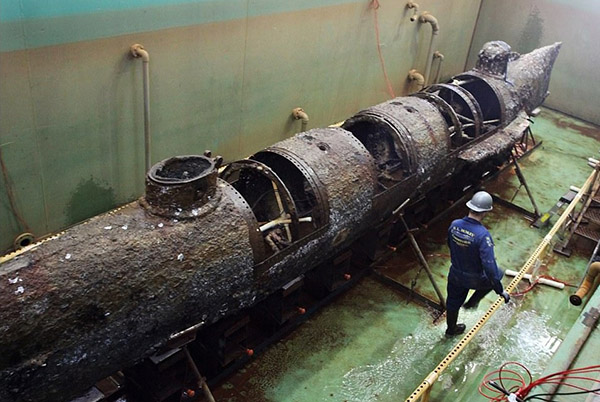The H.L. Hunley—the world’s first successful attack submarine, in service with the Confederate Navy in 1864—has finally revealed its propulsion secret more than 17 years after being raised off the ocean floor.
The Hunley was nearly 40 feet long, was built at Mobile, Alabama, and launched in July 1863. She was then shipped by rail on August 12, 1863, to Charleston, South Carolina.

The Hunley (then called Fish Boat) sank on August 29, 1863, during a test run, killing five members of her crew. She sank again on October 15, 1863, killing all eight of her second crew, including the designer, Horace Hunley, who was aboard at the time, even though he was not a member of the Confederate military.
Both times the Hunley was raised and returned to service.
On February 17, 1864, the Hunley attacked and sank the 1240-short ton screw sloop USS Housatonic, which had been on Union blockade-duty in Charleston’s outer harbor.
The sinking of the USS Housatonic—the world’s first successful submarine attack—was marred by final loss of the Hunley, which was probably too close to the deployed barbed spar torpedo when it exploded.
The Hunley was only finally located in 1995, and raised in 2000. Ever since then, it has been on display in North Charleston, South Carolina, at the Warren Lasch Conservation Center on the Cooper River.

Two scientists have spent the past 17 years collecting the crew’s remains and restoring the vessel as part of a painstaking cleanup operation.
While most of the remains were removed and ceremonially buried at Magnolia Cemetery in 2004, the researchers found a tooth stuck in a concrete-like mass of sand, mud and other debris at crank handle position Number 3.
It is believed that this is the position where crew member Frank Collins sat, a Confederate Navy Seaman who was just 24 years old when he sank with the Hunley.
Project lead archaeologist Michael Scafuri told the Post and Courier that the tooth loss was ‘post-mortem’, meaning that long after the sinking, the tooth came loose during the decomposition process and stuck to the crank handle where it corroded with the iron.
The find was made as the pair of scientists tasked with the submarine’s cleanup gave a project update during a media brief this week.
Alongside the tooth, the researchers announced that they had finally cracked how the submarine was propelled through the water.
Hidden underneath the rock-hard stuff scientists call ‘concretion’ was a sophisticated set of gears and teeth on the crank in the water tube that ran the length of the 40-foot sub.
These gears enabled the crew rotating the crank to propel the sub faster by moving water more quickly through the tube, conservator and collections manager Johanna Rivera-Diaz said.
The biggest surprise for Rivera-Diaz? Discovering that some of the men wrapped the crank handle in thin metal tubes covered with cloth to try to prevent blisters.
‘You get really concentrated on a specific area working every day. I was finishing the crank system. One day, when I was through, I just stepped back and “Wow, this looks amazing”,’ she said.
For 17 years, researchers have been painstakingly cleaning a century and a half of sand, sediment and corrosion from the historic submarine.
Their goal is to get it looking as close as it appeared on its mission as possible by removing gunk using a mixture of sodium hydroxide and a mild electrical current.
This gradually softens the concrete-hard buildup of sand, mud and shells that built up inside the vessel during the 140 years it was buried off Sullivan’s Island, so that the debris can be removed later.
The pair drain the 75,000-gallon tank of water and chemicals three times a week for several hours at the Confederate sub’s home in North Charleston, South Carolina.
Then, they go to work in full protective gear, bent around nooks and crannies, gingerly chipping the grime off the H.L. Hunley, all for moments like this, when they can show the world something new.
Scientists hope to resolve the mystery of how the sub sunk by cleaning the entire interior of the sub over the next several years.
It took one year to remove all the crud from its hull, and nearly two more to clean out the much smaller crew compartment, Mr Rivera-Diaz said.
‘It’s tough physically to do this every day. You are wearing special suits and using chemicals with high pH levels,’ she said.
The sub itself is only 4 feet in diameter. Eight schoolchildren can barely cram themselves into a replica nearby at the Warren Lasch Conservation Centre.
Up next for Mr Rivera-Diaz is cleaning the conning tower. Scientists have determined that it had a lock, but don’t know why. The submarine was too cramped for the men to move around.
The eight crew members were buried in an elaborate ceremony at a Confederate cemetery in Charlestown, They were the sub’s commander, Lt. George Dixon of Alabama, James A. Wicks, a North Carolina native living in Florida, Frank Collins of Virginia, Joseph Ridgaway of Maryland and four foreign-born men about whom less is known. One is still only known as ‘Miller.’